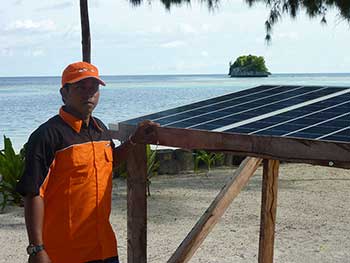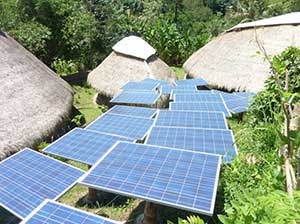Costs Of Solar Power

The Cost of Solar Power Generation - Is It Viable?
Solar Voltaic systems that generate electricity from sunshine have been developing steadily over the years. Until recently they were not really cost effective however all that has changed. More efficient solar panels and batteries combined with reduced production costs are making solar power a viable alternative. In many countries solar and wind power are quickly replacing coal, oil and nuclear power generation. So why are costs falling, how much power can we generate and what factors should we understand when considering a solar power generation system.
The Cost of Solar Power Generation
Solar Voltaic systems that generate electricity from sunshine have been developing steadily over many years. Until recently they were not really cost effective however all that has now changed. With a worldwide interest in cutting greenhouse gases combined with increased efficiency of solar panels and batteries there has been increased sales in solar voltaic equipment which in turn has brought the benefits of larger production runs and economies of scale which has finally brought the cost of solar power down to be cost effective. In major countries around the world the cost of generating solar power is now matching "dirty" generated energy and is overtaking dirty energy sources in terms of the amount of power being generated.
Mass production reduces costs
Mass production is a vital factor. Our whole world started to change dramatically in 1726 when the first cotton mills introduced the world to serious mass production. These days economies run on mass production and products survive or fail on it. We only have to think of the astronomical scale of the launch of an iphone or an ipad. Think of the logistics of launching a new smart phone and having to have around 5 million in stock ready to go on launch day.
The basic motivating factor is that mass production brings costs down dramatically. If you can increase sales sufficiently you can invest in more sophistication in the manufacturing department. In some cases mass production doesn’t manage to take its course.
A case in point is in the field of solar electric power. It has been around for some time now but somehow, until recently, the cycle of demand fuelling research to bring the cost of photovoltaic cells down doesn’t appear to have happened sufficiently to make solar panels viable.

Increased demand makes solar panels economically viable
Photovoltaics are semiconductors that convert solar radiation (sunshine) into electricity. As we know photovoltaic materials are used to make solar cells which are assembled into solar panels. These form the basis for photovoltaic solar power generation systems. Unknown to most of us photovoltaic systems are very common in many households in remote areas of Indonesia. These have been installed by the national power provider, PLN, in remote areas that do not have mains power distribution. These systems tend to be very small and only provide some rudimentary level of lighting.
In developed countries photovoltaic systems have been around for quite a while and are becoming used widely for situations where mains power is not readily available such as street lights, signs and traffic lights. Takeup of these systems for home power generation, however, is still at very low levels owing to the high cost of installing systems relative to the low levels of power such systems can generate.
Technology keeps advancing both in the generating capacity of solar panels and in the development of electrical equipment that uses lower levels of power. More specifically with the recent availability of high quality LED lighting we can reduce the power we need to light our homes and workplaces.
How efficient are solar panels?
Let us look at some basic considerations.
How much sunshine do we have? If you live in Australia where the solar radiation is higher than in most other parts of the world solar power is very effective.
Latitude has a major impact on solar power generation, the further away from the equator you are the lower the sun is in the sky and the more atmosphere the sun’s rays must pass through to get to you. To collect as much solar radiation as possible solar panels should be tilted to be at right angles to the sun’s rays. Bali is 8 degrees South of the equator so solar panels there should be tilted 8 degrees to the North.
Time of the day is just as important and most power is generated in the middle of the day when the sun is directly overhead.
Add to these factors cloudy skies and air pollution levels which both reduce solar radiation levels reaching your panels and we see that the theoretical maximum power output of a solar panel is seldom achieved and in addition panels must be kept clean and should not be vulnerable to shadows from trees or buildings. For calculation purposes we can assume that in Bali close to the equator we can expect to get 4.5 hours of effective sunshine per day.
A typical solar panel (depending on size and efficiency) can generate up to 200 watts of power in full sun. As we have said we can expect 4.5 hours of full sunlight a day giving us a total power generation from one panel of 900 watthours or 0.9 of a kilowatt hour (kWh) each day. Like all generation systems we have to expect inefficiencies which we can expect to multiply up to losses of around 45%, our panel will effectively give us around 500 watt hours of electricity per day.
To put this into perspective a one PK air conditioner (an average bedroom size) will use around 750 watts of power so in a full day on a sunny day our solar panel will generate enough power to run our air conditioner for only about 40 minutes. To run one air conditioner for 8 hours we will need 12 solar panels.
Solar electric systems are good for lighting but not for electric motors
Generally speaking photovoltaic systems are not good for supplying the power for electrical equipment that use electric motors such as pumps, air conditioners, refrigerators and washing machines or items that have electric heating elements such as water heaters, hair driers electric kettles and washing machine heaters.
Lighting and electronic controls such as security systems, however, are another matter and one solar panel can power 9 high power 5.5 watt LEDs for 10 hours, suddenly for certain applications solar power is starting to look viable.
Hybrid systems
This also opens the opportunity for installing hybrid systems that use different power sources for different purposes so, for example we can combine gas for cooking, mains electrical power for pumps and air conditioners and solar for heating water and lighting.
Solar power generation is one area where technological advances have been disappointingly slow probably due to a lack of serious investment or will. Finally this is changing. New developments are progressing with a new type of photovoltaic being worked on that promises to boost the amount of power one solar panel can generate. Now we are getting over the “hump” in the initial developmental period and the mass production cycle is getting going we are starting to see more development and lower prices, solar generated electricity is starting to take off.
Copyright © Phil Wilson 23 January 2013
This article, or any part of it, cannot be copied or reproduced without permission from the copyright owner.
